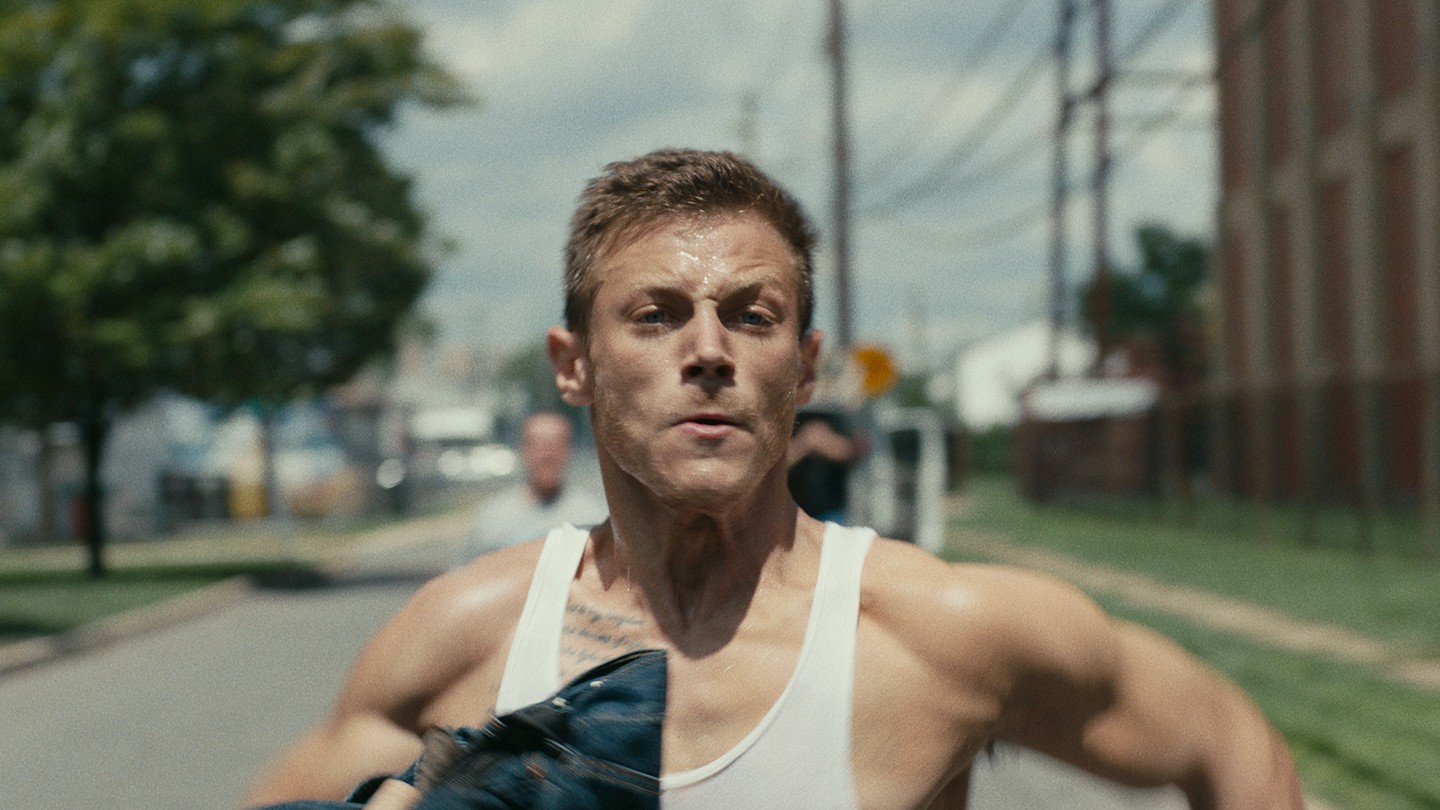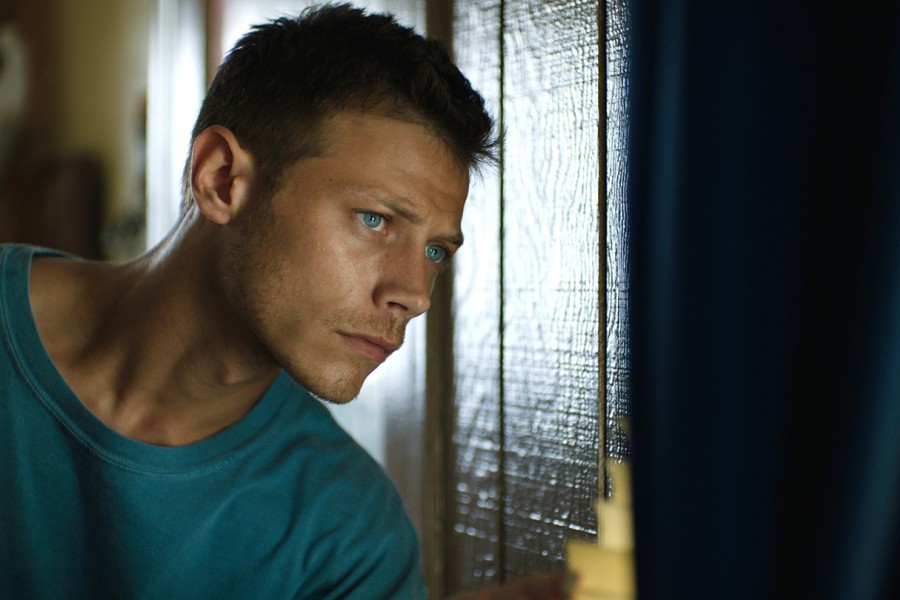For 24-year-old Keith, there's more to this world than the working-class Dundalk neighborhood he grew up in. But to discover it, he'll have to navigate the tightrope between a future he hasn't yet imagined for himself and his criminal past.
Sollers Point, the new film by director, writer, and Johns Hopkins lecturer Matthew Porterfield, opens Friday at the Stavros Niarchos Foundation Parkway Theatre. The movie follows Keith (McCaul Lombardi), a working-class kid trying to re-enter society after a prison sentence and house arrest.
Porterfield, who teaches in JHU's Program in Film and Media Studies, distills Keith's journey into a series of encounters with the people in his life who are doing what they can to support him—his father (Jim Belushi), with whom he lives; his sister (Marin Ireland); his grandmother (Lynn Cohen); his ex-fiancée (Atlanta's Zazie Beetz); a former friend-turned-aspiring rapper (Brieyon Bell-El); and former gang acquaintances and connections made in prison that threaten to send him down a far-too-familiar path.
Video credit: Oscilloscope Laboratories
The film, Porterfield's fourth, is gorgeously shot by Shabier Kirchner, who was recently named one of "10 Cinematographers to Watch" in 2018 by Variety. Its screening at the Parkway marks the first of a platform release scheduled for 11 cities in the coming weeks, with an option for additional showings depending on its box office performance. A Q&A with Porterfield and Lombardi will follow the 7:30 p.m. screenings on Friday and Saturday.
In advance of the premiere, The Hub caught up with Porterfield to talk about building complex characters, telling working-class stories, and the colors of summer in Baltimore.
I know with your films that there's often a story behind the stories we see on screen. How did this one develop, and did it change much from page to screen during the production process?
This script took me a long time to write—at least the better part of three years. I was thinking about the image of a man on house arrest with an ankle bracelet, specifically of a friend of mine who was on home detention. That image just carried me for a while. Originally, [this character] was going to be on home detention for the entirety of the film but I realized there was something exciting about the character regaining his freedom along the way. After several drafts, the actual period that he's on house arrest was diminished significantly and most of the film is about this transition back to society.

Image caption: In Matthew Porterfield's Sollers Point, McCaul Lombardi plays Keith, a 24-year-old who must navigate the tightrope between a future he hasn't yet imagined for himself and his criminal past.
Image credit: Courtesy of Matthew Porterfield
When I was writing, I started to think of the film as a road movie, structured in a linear way, involving lots of characters that he meets. I've always loved that genre. But there was certainly an evolution during production. Things changed. I became aware that the ending I had written wasn't really working, so we shifted focus and added a shoot to realize what I thought would be a better ending, which is what you see in the final film.
Without giving too much away, I want to bring in the theme that I really like—when Keith takes the art student, Aurora, to the kind of dodgy home in order to get something. In almost any other movie, this type of scene would be told through the eyes of the middle-class young person feeling out of place in a potentially sketchy situation. In showing this scene through his eyes, you're showing the kind of lives that rarely get seen on screen. Was there an element of wanting to look at the life of somebody who doesn't get this sort of treatment in movies much, if at all?
Definitely. I think all of my films attempt to do that to a certain extent. I think that just comes from a desire to depict the diversity of the American middle class that we don't see a lot on screen or see portrayed with much authenticity. Yes, Keith is clearly comfortable in this environment and this girl he meets is not, and I think the audience should be aligned with Keith throughout the film, even if at times they feel alienated by him. I think that the film strives to carry you alongside Keith, keep with his perspective. That was my intent.
Also see
Let's talk about that perspective a bit. I like thinking about the film as a road movie through his transition back into society. It's a tough journey. On the one hand, Keith is a working-class white guy who doesn't entirely recognize how people close to him are trying to help him get a second chance. At the same time, he's learning that really hard lesson over the course of the film about probably just how finite his options in life are. How did you go about visualizing that journey as a cinematic experience?
It's a fine balance because there are a lot of external factors that are making Keith's transition to the free world, if you will, difficult. But some of the greatest challenges are the obstacles that he set for himself: his self-hating tendencies, impulsive behavior, and bad decision making. I was just really thinking about myself, kind of putting myself in his position and thinking about how I would respond if I was making the most impulsive, self-destructive choice. I have impulsive and self-destructive tendencies, and I was trying to make decisions from that part of my psyche, if you will. I always try to write from a first-person perspective, to really inhabit the characters, at least the protagonist. It has to be a character that I really understand and can get inside, and understand their behavior because it's a behavior that I know, personally, that I share. So I was writing Keith and thinking of my worst tendencies.
What was it about McCaul Lombardi that gave you the sense that he could carry a film? Because he's not only the protagonist, he's in every scene, and this arc you've put him on is difficult and subtle. That's a big ask.
I think he has a real vulnerability, which comes across on screen and translates to pathos. It was really important to find somebody that had that—you know, you're asking the audience to connect with this difficult, unreliable, at times challenging individual, so the performance is what is going to bring them in. I needed someone who ultimately the audience would fall in love with, even if they get frustrated with him along the way. And McCaul has that vulnerability.
He also has a physicality that's really beautiful. You like watching him move. He has this coiled energy, which, to me, embodied the character's more impulsive behavior. He's all wound up inside, and you can see it. So there's an unpredictability, too, which makes him interesting.
Why do you think working-class lives are so rarely seen in cinema these days? Why don't we see those stories being told?
I think because most filmmakers and makers in other fields are coming from an upper middle-class background. This is not a world they know, and if they choose to tell a story about the working class, it's from sort of an anthropological or ethnographic perspective, which results in caricature. I'm writing about my neighborhood and the people I grew up with. I feel like it's something I know intimately, and the stories I want to tell happen to be of this milieu.

Image credit: Courtesy of Matthew Porterfield
I think it has to do with class, the class of makers, and also a little bit that film is a kind of an escapist medium in some regards. People would prefer to see stories about people who are living in big cities, New York or L.A., and who are relatively affluent compared to the characters in my films.
This is your first time working with cinematographer Shabier Kirchner after working with Jeremy Saulnier twice. How do find such good directors of photography?
Oh man. Shabier was introduced to me by one of my producers, Alexandra Byer, who is actually a Hopkins graduate. They had worked together on some commercials and short films, and we hung out a couple of times. I really liked him and then I took a look at his reel and I appreciated his sensibility, his sensitivity to light, and also his ability as a camera operator. I liked the way he held the camera, in other words. And he has an incredible work ethic, also just generally a positive, beautiful energy, which makes people want to work for him. Jeremy had those same attributes, so I was lucky to find Shabier for this film and I would love to work with him again.
Were there any particular visual ideas you wanted to explore with Sollers Point? You mentioned you had the image of the man with the ankle bracelet in your head. And while this film takes place over time, it does a great job of catching that sunny, summery yellow that sometimes washes through Baltimore that I don't often see on screen.
I love that summer palette, and in terms of color, I feel this film is most akin to Hamilton, my first feature—something about the greens and the yellows and the orange and the red. Shabier and I walked through every location to every scene together with a still camera before we shot. And we favored medium closeups more than in my previous films, which rely heavily on the wide master where a lot of action takes place in a single take with a fixed camera position. There's also a lot more hand-held camera work in this film.
We wanted it to be a little closer and moving more. And that's really because we wanted to stick to Keith. We wanted to get the audience as close to him as we could without just following him around with a Steadicam. The moves have to be motivated by the actions. So that was the challenge.
You mentioned one of your producers is a Hopkins alum, but I also seem to recall that a number of students were involved in the production.
We had approximately 12 students, mostly from Hopkins but some from MICA, and some recent graduates as well. Alexandra Byer, who graduated in 2011, is one of my producers. And Abby Harri, another graduate, did all my background casting and did a tremendous job on that. We had a former student who was the second assistant director, a lot of students worked on the project as PAs or grips, and the list goes on. It was a cool opportunity to have people learning on the job, having their first real, on-set production experience. I think it serves to remind the professionals that learning is happening and we're trying to create a healthy atmosphere for everybody on set.
Are you working on anything now? Do you know what your next project might be?
I have a script that I've been working on that didn't originate with me. Two friends of mine wrote it with me in mind to direct. And I stepped in and have been working on the last couple of drafts. The story is called Check Me in Another Place, and it's about a rapper in his 40s who is touring France and Belgium with his 10-year-old son, who is being raised in Paris by his French mother. It's a story about a guy approaching middle age, mid-career, whose practice maybe isn't as lively as it was in his 20s and 30s, getting to know his son more or less for the first time. And he's trying to decide how he can be a father.
Posted in Arts+Culture
Tagged film, matthew porterfield, film and media studies, baltimore










